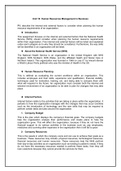Essay
Unit 16: Human Resource Management in Business P1, M1
- Course
- Institution
P1: describe the internal and external factors to consider when planning the human resource requirements of an organisation M1 explain why human resource planning is important to an organisation
[Show more]






